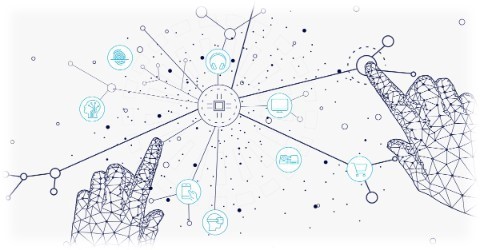
Business Innovation Manager KBC

KBC Enterprise Architect
There are various ways to integrate a partner's service or product. They all have their benefits and drawbacks as well as certain consequences when it comes to performing essential maintenance, dealing with data management and concluding key technical contracts. This blog is part of a series in which we guide you through the various integration options.

APIs, widgets, endpoints and SDKs: seasoned developers use these terms all the time. But what do these integration methods mean and why do we need to have so many options? What happened to keeping things simple?
All these variations have the same aim: to unite a product or service from one party with your own portfolio of services, so that you can provide your customers with an integrated service. Adding a payment button on a website is a simple example of this.
Why integrating an external service can benefit you
Imagine you are a furniture seller. In addition to providing information online, you want to sell furniture via your website. Furniture is your core activity and you're good at it. You want to make the most common payment methods available for customers purchasing items over your website. Doing this yourself has two drawbacks: it is complex and takes away your attention from selling furniture.
This is why you seek out a partner which is well versed in offering, integrating and maintaining payment options and making it as simple as possible. The partner you choose has to make a suitable offer in terms of the process and technical (IT) solution involved. While the market is now relatively standardised as far as payment solutions go, this is not the case for new integration options. Your partner can offer various methods that match your preferences, whether that is an API, widget or SDK, or a combination of all three.
All of these methods have their perks. It is possible for the same service to have various integration options. You can integrate a certain service into your portfolio via an API and a widget. A list of options – ordered from least amount of IT integration required to most – is provided below.
From APIs to QR codes: a list of payment options
API
APIs are a hot topic at present. API stands for 'application programming interface' and is a way to use the features of third-party software in your own system. This is the most technical integration method on this list. An API builds a bridge between your software and that of another party. Your data is exchanged via that bridge, so you can use the features of the third-party software in your own suite. The benefit is that the customer doesn't have to switch between environments. In fact, if the integration is seamless and incorporates the look & feel of your platform, they won't notice anything – even if they are interacting with the third-party software via your own.
Exchange rates are a good example of this. Say you want to display the GBP to EUR exchange rate on your website. You don't want to have to keep manually updating it to reflect the most recent rate. An API would automatically send you the correct exchange rate and calculate the prices automatically, leaving you to focus on your core business activities.
Widget
A widget is another integration option. This is a self-contained piece of code that runs on your website and is supplied to you by another party, e.g. KBC. When added to your website, the code shows a screen that allows visitors to your website to interact with KBC.
A common example is the Google Maps widget found on many websites. Google provides all the information on the map and the user features. The consumer does not have to leave the website to be able to access or use this information.
Another benefit is that you can send new widgets to your customers if something changes on your website (and they can do the same). On Airbnb, for example, you will receive new accommodation suggestions if you check out different areas of the map. The map itself is the widget provided by Google Maps, while the address suggestions are provided by Airbnb. They adapt to each other depending on the actions taken by the customer.
Finally, you can change the widget's appearance to bring it in line with your website's style, thus creating a seamless overall look & feel. A pop-up chat window on a website is a good example of this.
iFrame
An iFrame is a common alternative to a widget. The name iFrame comes from 'inline frame' and literally serves as a window into your website: an iFrame cuts a hole in your website and fills it with with a different website. In comparison to a widget, this drastically reduces the interaction options between your website and the website in the iFrame. The major advantage of an iFrame is that any changes to your website have virtually no impact on the iFrame or its content and vice versa.
SDK
An SDK or software development kit is an integration method that is prevalent in app development (both Android and Apple), though it can be used in different settings. With an SDK, a piece of code is delivered together with the kit so that you may integrate it into your mobile app. This software is intended to enrich your app with features that you don't have to maintain yourself. The app builder performs the maintenance for the original software. The advantage here is that you can give the software instructions from your own app. The Adobe Analytics SDK for smartphone apps is a good example of this. If you integrate this software into your app, it is easy to monitor who is using your app as well as for what purpose. Adobe measures the traffic in your app and maintains the analysis software. In return, you receive a report listing the findings.
SDKs, widgets and iFrames all process the data entered into them. The difference lies in how each one does it. We'll take a look at this in more detail in a subsequent article.
URL
A URL or link is an integration method that has become so assimilated that most no longer consider it an integration method. We're mentioning it here because adding a URL gives you the option to add an extra service to your existing portfolio. For example, if you add a Facebook login option to your website, this is actually a link that will send your visitors to Facebook when they click on the login icon. After they have logged in to Facebook, they will be sent back to your website. In other words, the link is an essential element of the integration. Full integration goes further than just a link – it depends on the technical contract that you have with Facebook. What are technical contracts? We'll tell you all about them in another article.
QR code
The final item on the list: a QR code is also a link, albeit one you can use in the physical world. The information contained within this code is limited in length and virtually always refers the user to a website. The advantage of a QR code is that it can contain additional information, allowing you to personalise the link. If you scan the QR code from Payconiq when shopping at a retailer, the code will provide you with the details of the beneficiary straight away.
Maintenance
At the heart of all these technologies is the ability to integrate a product or service of a third party. You should choose the integration method based on how you specifically want to enhance your customer experience. We'll take a look at the consequences of choosing specific integration techniques – including elements like who is responsible for maintenance and supervision – in another article.

Would you like to know more about our integration options?
You will find an overview of the various business solutions and technical integrations on the KBC Developer Portal.



